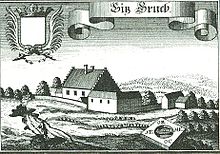Seat Grub
The castle or seat of Grub (Pfarrkirchen) is located in the Untergrasensee district of the town of Pfarrkirchen in the Rottal-Inn district of Bavaria in Lower Bavaria . The seat was endowed with the lower jurisdiction until 1820 .
history
In 1494 Ruprecht Neunhauser, Pankraz Magens and Jörg Gruber are reported as the owners of Grub. Around 1500 Pankraz Magens, Peter Angerer, Stephan Scherffeder and the brothers Wernhart and Sebastian Gruber are mentioned here. In 1510 the property is in the hands of the Sighart Grubers zu Grub. After that (until 1537) a Sebastian Gruber can be proven here. Conrad Gruber died in 1569 without a male successor, so his four daughters received the seat; Zacharias Höhenkirchner zu Iffeldorf and Stubenberg acted as fiefdom bearer, and carer on Reichenberg . On January 20, 1574, Sewald Höhenkirchner is proven as a fiefdom holder for the sisters Rosina and Corona Gruber in a fiefdom lapel. Through the marriage of the Corona, Grub came to Diepold von Burgau in 1585. After the death of Corona Gruber († April 7, 1585) Grub came to her children Desiderius and Joachalina. In 1620 Joachalina's share went to her brother alone and the following year to his father Diepold. After his death, Grub came to Joachalina von Burgau, married Khädinger. Through a contract, her brother's share (1637/38) was also given to her. The elector's court councilor M. Johann Agricola is named as her fiefdom holder.
On March 11, 1639, the fiefdom of Joachalina von Burgau and her husband Johann Anton Khädinger passed to their son-in-law Alexander Schrenk, electoral keeper of Dießenstein. The Schrenks remained in the possession of Grub until 1727: in 1652 Alexander Schrenk von Notzing had received the seat through his ruler Ernst von Asch, after his death († 1675) Alexander Ignatius Schrenk von Notzing was in possession of the fief from 1678, including his own Brother Hans Carl and his sisters Maria Corona and Anna Franciska owned. In 1680 Grub passed entirely to Alexander Ignatius Schrenk. In 1719 Franz Adam Ignati Baron von Schrenk and Notzing enjoyed Grub, which he had received through his power owner Johann Balthasar Dräxl, electoral court secretary and registrar in Munich. After the death of the last of this family, Franz Adam Baron von Schrenk, the fiefdom reverted to the elector and he gave it to the fiefdom holder Maximilian Franz Freiherr von Scharpfsedt auf Kollersaich, court chamber director and trustee, for the daughter Maria Franciska Josepha, in 1727 Freein von Schrenk. Since this nun was in the Frauenchiemsee monastery , her share and that of her brothers-in-law could be handed over to Maria Irmengardi, abbess in Frauenchiemsee, via the monastery judge Mathias Benno Xaverius Ridl (1735). Then the monastery judge Mathias Ridl bought Grub on March 22, 1735 and was given it as a fief. After his death († June 22, 1739) it went to his sons Joseph and Benno, who were represented by their guardian Joseph Rosner because they were minors. On March 14, 1760, Benno Ridl is named as the sole owner of the feudal rights, as his older brother had entered the Seeon monastery .
On March 11, 1761, Benno Ridl, now electoral adjoint care commissioner and brewery manager at Traunstein , sold the estate to his stepfather Johann Joseph Münsterer, electoral court attorney and conductor in the monastery on the Anger in Munich. The Grub headquarters remained in the possession of the Münster family until 1820. Then the parish church merchant Maria Doppler bought the seat. The associated jurisdiction was withdrawn from the district court.
On the engraving by Michael Wening from 1721, the Grub seat appears as a single-storey building with stepped gables on both sides. Further farm buildings are attached; the facility is surrounded by a picket fence.
literature
- Ilse Louis: Parish churches. The nursing courts Reichenberg and Julbach and the rule Ering-Frauenstein. (= Historical Atlas of Bavaria, part of Old Bavaria, issue 31). Michael Laßleben Verlag, Munich 1973 (pp. 284-287). ISBN 3-7696-9878-9 .
Coordinates: 48 ° 25 ′ 18.8 ″ N , 12 ° 57 ′ 55.4 ″ E


